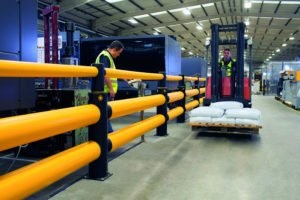Complete Powerpoint slide presentation for forklift instructors. Ready made training course
top tips for segregating forklifts and pedestrians
 Tim Waples, Chief Executive of the Fork Lift Truck Association, explains why now is the perfect opportunity to do a complete site audit and improve all on-site safety measures, particularly those designed to protect workers on foot.
Tim Waples, Chief Executive of the Fork Lift Truck Association, explains why now is the perfect opportunity to do a complete site audit and improve all on-site safety measures, particularly those designed to protect workers on foot.
Recently, businesses everywhere have had to update their sites to incorporate social distancing. But I’d ask ‘Why not go an important step further and use this time to review all areas of site safety to identify what other positive changes can be made?’
For instance, the lesson on keeping a safe distance can easily be applied in areas where forklifts and pedestrians interact. Every year there are hundreds of accidents that involve a forklift and a someone working in close proximity on foot at the time. This includes pedestrians doing tasks unrelated to the forklift, supervisors, and delivery drivers overseeing loading and unloading of their vehicle.
Many companies have hired more staff or changed peoples’ role during the past few weeks to cope with the changes in demand for goods, meaning there could be more pedestrians on the shop floor working near forklifts than ever before. Neil Lennox, Head of Group Safety & Insurance at Sainsbury’s, recently told SHP: “Normally the way it works is you have two people riding a specially designed low-level order picker, but to adhere to social distancing, we had to have one person on the machine, another meet them at the pick slot, do a short burst of activity together, ten seconds or so, then move on.” Neil said, “this has added an extra level of complexity,” with more people moving around the warehouse on foot, than in normal circumstances.
Perhaps this period of adjustment and change will be the inspiration to finally make much-needed safety updates, especially if a site has not been reviewed in a long time.
The good news is that there are many measures that can easy be put in place to separate lift trucks and pedestrians, and these can be adapted depending on site, budget and layout limitations.
1. Carry out a risk assessment
The first step is to conduct a risk assessment of your site. This will help you to identify any dangerous areas that need to be addressed. To support with this, the FLTA website has a wealth of resources, including designated risk assessments for pedestrian operations, and Safe Site Checklists, which are available free via its Access All Areas initiative.
2. Create designated walkways
Pedestrians and materials handling equipment should be totally segregated wherever possible. In areas where working in the same space is unavoidable there should be clearly marked pedestrian routes and signposted crossings. These routes can be painted lines and signage, but physical barriers are more effective. Overhead walkways may also be an option where floor space is really tight.
If possible, assign separate spaces for lift truck parking and maintenance, so that operators and engineers are not working around a truck and potentially in the path of other moving vehicles.
3. Modify your trucks
Adding safety features to your forklift can reduce risk of accidents significantly. There are lots of innovative products available, such as anti-collision systems, proximity sensors, blue lights that alert pedestrians, and safety zone lights that are projected around a forklift, effectively creating a constant exclusion zone. It may also be helpful to attach cameras to capture operations.
Where necessary, speed limits can be introduced. One-way systems are also effective to avoid the risk of collisions. Ensure optimum lighting and add mirrors to blind corners to enhance visibility, particularly for indoor operations.
4. Communicate with staff
Make everyone aware of the risks and consequences of working around forklifts by providing sufficient training and hosting regular health and safety meetings. If operators and pedestrians have a clear – and shared – understanding of safe working procedures, they will be able to confidently perform their daily duties in line with best practice. Courses are available that bring both operators and pedestrian colleagues together. As a manager, be sure to continually engage with staff and monitor day-to-day operations so that complacency doesn’t creep in and lead to bad habits.
Where pedestrians and operators do work closely, to is also important for them to have safe ways to interact. Our Safety Partner Mentor devised an easy 3-step, non-verbal communication system for operators to use when working alongside pedestrians. The Show Your Hand concept is simple: if a pedestrian comes too close to a forklift the operator simply raises their hand indicating that the colleague on foot should stop. If they don’t notice or comply then the driver must switch off the truck, to prevent any risk of an accident. Show Your Hand kits, including posters and videos, are available free of charge via the Mentor website.
5. Contact your local FLTA member
FLTA members are highly experienced in materials handling operations and can offer in-depth guidance and advice on working safely on site.
FLTA has a number of valuable materials available on its website, including a dedicated COVID-19 Resource Centre.
Disclaimer. The legislative information contained on this web site is my interpretation of the law based on many years in the health and safety business. A definitive interpretation can only be given by the courts. I will therefore not be held responsible for any accident/incident/prosecution arising as a consequence of anyone using any information obtained from this web site.